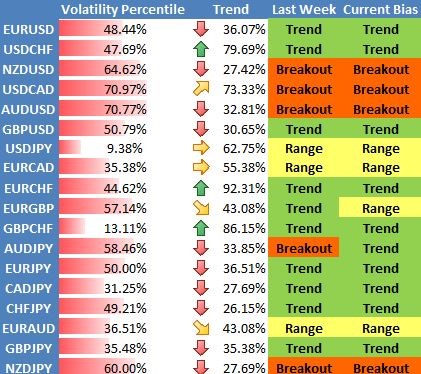In the ever-volatile world of forex trading, identifying trends is crucial for making profitable decisions. Whether you’re a seasoned trader or just starting out, grasping the art of trend analysis will give you a significant edge in the markets. Here’s a comprehensive guide to help you decipher the intricate dance of currency movements and ride the waves of profitability with ease.

Image: derivbinary.com
Defining Forex Trends
A forex trend refers to a prolonged movement of a currency pair in a specific direction. Identifying trends allows traders to predict future price movements and position themselves accordingly. Trends can be categorized into three primary types:
- Uptrends: Occur when the price of a currency pair consistently rises over time, forming higher highs and higher lows.
- Downtrends: Indicate a sustained decline in the price of a currency pair, characterized by lower lows and lower highs.
- Sideways Trends (Ranges): Describe periods of price consolidation, where the currency pair moves within a horizontal channel without a clear upward or downward bias.
Identifying Trends with Technical Analysis
Technical analysis is a potent tool for identifying forex trends. By studying price charts and applying various technical indicators, traders can gain insights into market behavior and anticipate future price movements. Here are some popular technical analysis tools:
- Support and Resistance Levels: Identify areas where prices tend to pause or reverse direction. Support refers to horizontal lines below the price, indicating levels where buyers step in and push prices higher, while resistance denotes lines above the price, marking areas where sellers attempt to cap gains.
- Moving Averages: Smooth out price fluctuations by calculating the average price over a specific period, helping to identify overall price trends and potential trend changes.
- Trendlines: Drawn along series of highs or lows, trendlines indicate the underlying trajectory of a trend and can be used to predict potential breakouts or reversals.
- Candlestick Patterns: Japanese candlestick patterns analyze the relationship between open, close, high, and low prices within a trading period and can provide valuable signals about price momentum and trend direction.
Practical Tips for Trend Trading
- Consider the Higher Timeframes: Focus on identifying trends on higher timeframes (e.g., daily, weekly) as they provide a more reliable indication of market direction.
- Use a Combination of Indicators: Don’t rely solely on a single technical indicator. Employ multiple indicators to confirm trends and minimize false signals.
- Price Action is Paramount: Technical indicators offer insights, but always give precedence to the price action itself. Observe how prices interact with support and resistance levels, trendlines, and candlesticks.
- Trend Reversals: Be cautious of trend reversals and identify them using key indicators such as double tops/bottoms, divergences, or breakouts of moving averages.
- Risk Management: Protect your capital by implementing a sound risk management strategy, including defining stop-loss levels and position sizing judiciously.

Image: www.forexsmarttrade.com
Real-World Example: Identifying an Uptrend
Consider the EUR/USD currency pair. After a prolonged downtrend, the price bounced off a key support level in March 2023, coinciding with a positive divergence in the Relative Strength Index (RSI). This signaled a potential trend reversal.
Subsequently, the price formed higher highs and higher lows, establishing a series of ascending trendlines. Moving averages such as the 20-day MA confirmed the uptrend, indicating a shift in market sentiment from bearish to bullish.
Based on this analysis, traders could have identified an emerging uptrend and positioned themselves for potential gains by buying the EUR/USD pair strategically.
How To Know Trend In Forex
Conclusion
Mastering the art of trend identification in forex trading empowers traders with the ability to navigate the ever-changing markets with confidence. By employing the principles and techniques outlined in this guide, you can decipher the language of currency price movements and increase your chances of making profitable decisions. Remember to conduct thorough research, apply risk management strategies, and stay adaptable to the volatile nature of the markets. So, embrace the thrill of trend trading and ride the waves of Forex profitability!






